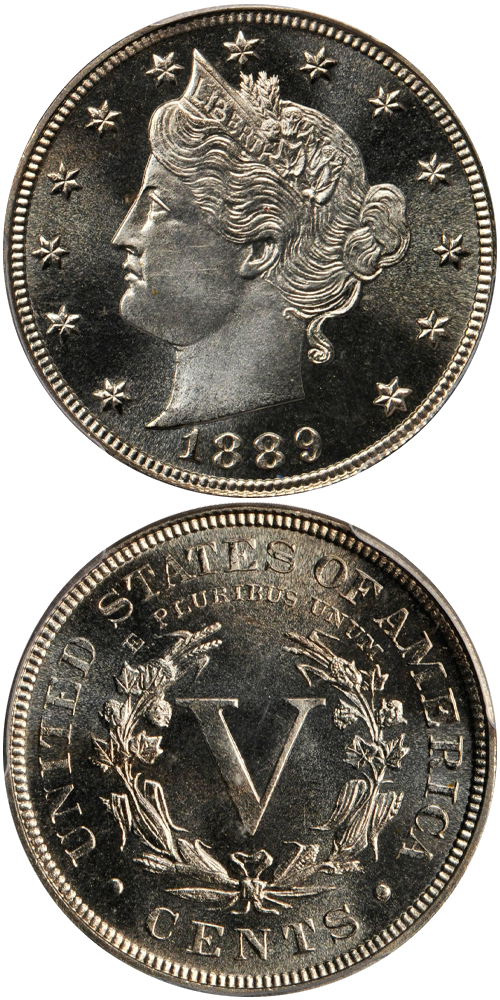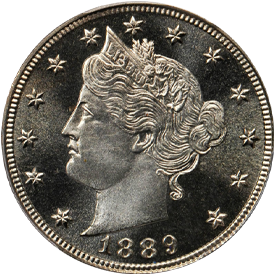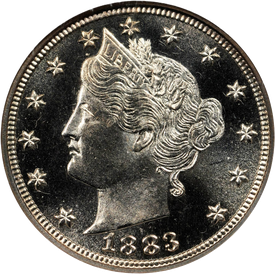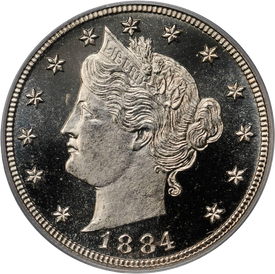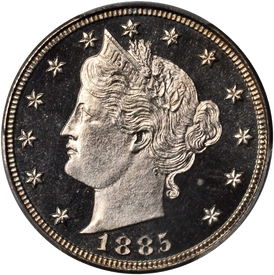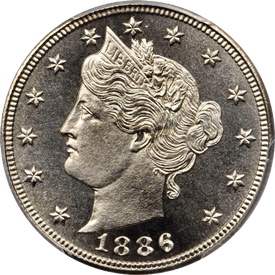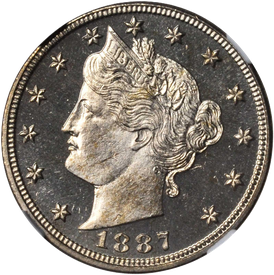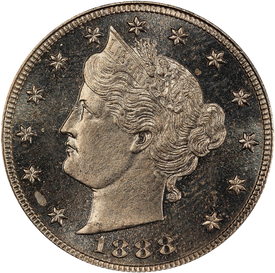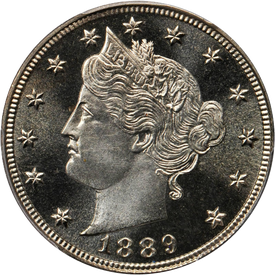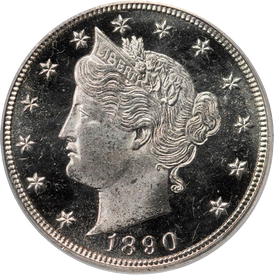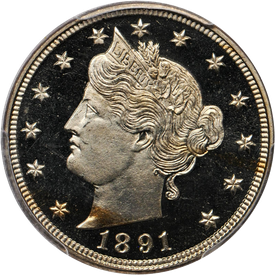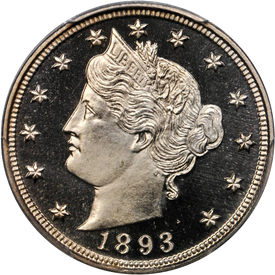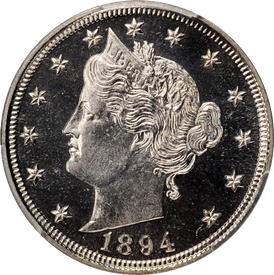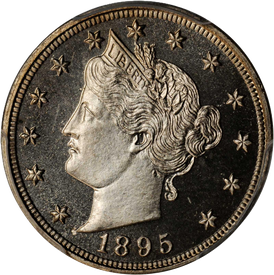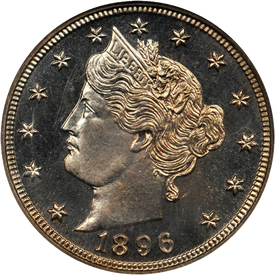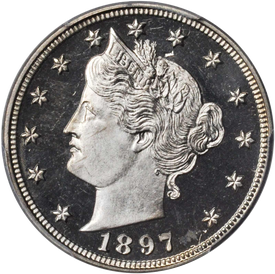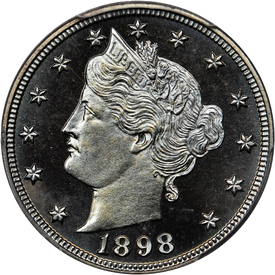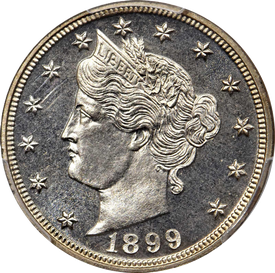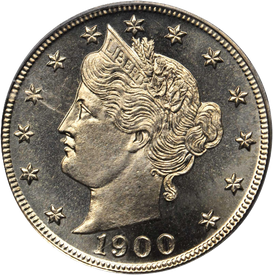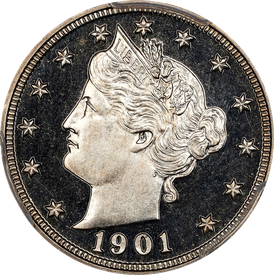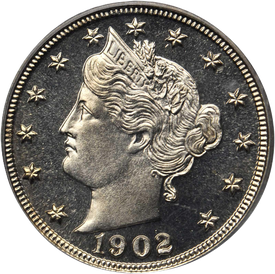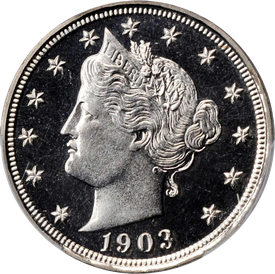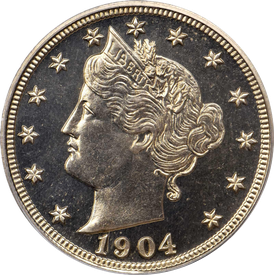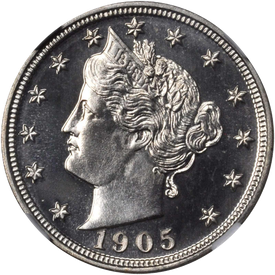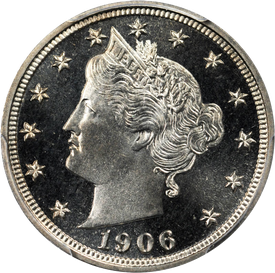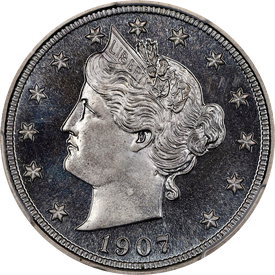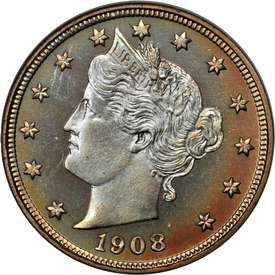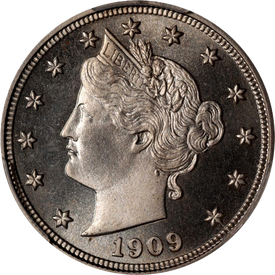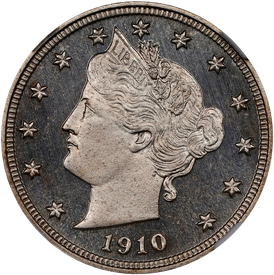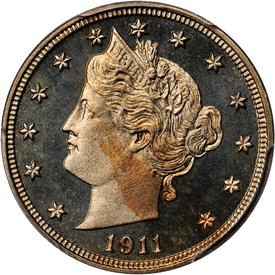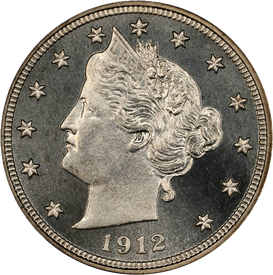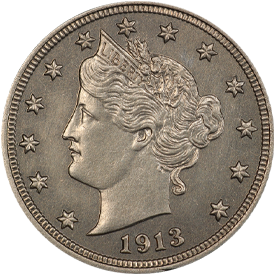Designed by: Charles E. Barber
Issue Dates: 1883-1913
Composition: 75% copper, 25% nickel
Diameter: 21.2 mm
Weight: 5.00 grams (77.16 grains)
Edge: Plain
Proof Mintage: 79,923
Proofs were made of all varieties from 1883 through 1912. Mintages were considerably higher than for the Proof silver coinage averaging about 2,800 coins annually. These varied from a low of only 1,475 in 1907 to a high of 6,783 for the 1883 “With Cents” variety. Today, most certified Proofs fall into the PR-63 to PR-66 range with ample quantities available in all these grades. PR-67s are also quite easy to acquire, with a certified population exceeding two thousand pieces. By PR-68, the going gets tougher, but they are by no means terribly challenging, as just over two hundred pieces appear to be extant. That is effectively as high as they get though, as at present, only one PR-69 is known – a cameo example graded by NGC.
Cameo contrast is found on between 10-15% of the certified examples but Deep or Ultra cameos are scarce, and appear on fewer than 1% of the graded coins. Deep cameos are virtually unknown between 1902 and about 1908 but can occasionally be found before, and after those dates.
Due to the large number of certified examples in the market, prices are not extremely high, with Choice (PR-63-64) examples in the $300-$500 range, Gem (PR-65-66) coin in the $500-$1,000 range and Superb Gem 67’s available in the $1,000-$1,500 range. If you need a PR-68, the jump is wide and prices range from around $4,000 to over $10,000. Of course, cameo contrast will add significantly to the cost, in some cases double or even triple the aforementioned prices.
As numismatists were also caught up in the desire to own 1883 Liberty nickels without the CENTS feature, the Mint made 5,219 Proofs, one of the highest Proof mintage figures ever. Apparently, many of the nickels were sold in sets, for large numbers of 1883 Proof Shield nickels and Liberty nickels with CENTS were also produced.
During the production of 1903 Liberty nickels at the Mint someone made a glaring mistake. During the striking of some pieces, the dies, rather than being oriented 180 degrees apart (so that the reverse appears upside-down), were aligned in the same direction. Of the total mintage of 1,790 Proof nickels of the year it is doubtful that more than a couple hundred had this slip. This issue, which has been overlooked by most cataloguers, first came to my attention around 1961 when my firm acquired the beautiful collection of coins formed by Ambrose Brown of Penn Yan, New York. His set of Proof Liberty nickels was mounted in a type of holder in which both sides of each coin are visible. Upon looking at the reverses I noticed that one was upside-down in relation to the others. I immediately thought that the coin had been placed in the holder upside-down, but upon examining the obverses of all the pieces I found that they were aligned properly. Ever since that time I have been on the lookout for 1903 Proof Liberty nickels with inverted reverses, and I have seen perhaps a dozen examples.
The rarity of Proof Liberty nickels is not particularly related to the rarity of Uncirculated Liberty nickels. As an example, 1,475 Proofs were made in 1907 as compared to more than 39 million business strikes. The Proof mintage ranks the 1907 as the rarest Proof in the series, while the generous business strike mintage reflects the situation that specimens in grades up to and including Uncirculated are among the most plentiful of the later dates. On the other hand, 1885, a prime scarcity in Uncirculated condition, is not particularly elusive in Proof, for 3,790 were struck in the latter format.
The 1913 Liberty Nickel
The last coin in the Liberty nickel series, the 1913, is a story in itself. In 1972 the Numismatic Scrapbook Magazine ran a fascinating feature article written by Courtney Coffing. The text delved into every aspect of this famous issue: how it was made, how it was publicized, the history of specimens trading over the years, and the collections possessing them. The story is one of the most absorbing I have ever read.
Not an official mint issue, the 1913 Liberty Head nickel was made privately at the Philadelphia Mint, presumably by one or more employees there (and also presumably without the knowledge of the officials of that institution). Samuel W. Brown, who supervised the security of the dies but who later moved to North Tonawanda, New York, to serve as mayor (and who later achieved minor publicity as a coin collector), has been pinpointed as the likely originator. At the time of issue, the existence of the 1913 Liberty nickel was known only to the person or persons who made them. It was not until 1919 that Brown ran advertisements in The Numismatist seeking to buy such pieces, as if he knew they existed.
Then, magically, at the 1920 ANA convention he appeared with a display of five of them! The implication, of course, was that he had bought them through his advertisements, but in later years when it was disclosed that he worked at the Mint in the coining department in 1913, a situation generally unknown to collectors in 1920, his source became suspect. Since no others have come to light since 1920, it is presumed that just five were struck, but the true story probably never will be known.
The 1913 Liberty nickel achieved fantastic fame during the 1920s and 1930s when B. Max Mehl used it as a focal point of his advertising to sell copies of his Star Rare Coin Encyclopedia, a compact volume which discussed all types of coins and listed the prices he would pay for them. He spent hundreds of thousands of dollars yearly advertising in magazines, newspapers, Sunday supplements, and even on the radio. Millions of citizens looked at their change hoping to find a rare 1913 Liberty nickel. None did. Thus, the coin became a household word with the American public.
Whenever a 1913 Liberty nickel changes hands publicly it is a matter of great interest to collectors and dealers. The J.V. McDermott specimen of this coin, bought by Aubrey Bebee for $46,000 at the American Numismatic Association convention in 1967, made headlines as did the purchase by World Wide Coin Company of the Edwin Hydeman coin from dealer Abe Kosoff. The latter specimen was handled by my firm, and through another company, Superior Galleries, was sold into the Jerry Buss collection. Another example, for which my firm provided an appraisal, was donated by Hon. and Mrs. R. Henry Norweb to the Smithsonian Institution in 1982. More recent sales during the decade of the 2010s have ranged in the $3–$4.5-million-dollar range.
While owning a 1913 Liberty nickel is the stuff of which dreams are made, and few will ever have that opportunity, the assembling of a set of regular issue Liberty nickels from 1883 to 1912 is a realistic goal. The most elusive issues are 1885 and 1912-S, followed by 1886. For those who can afford it, a run of Proofs, plus Uncirculated examples of 1912-D and 1912-S, forms a nice set. Much more difficult to piece together, but less expensive, is a run of Uncirculated pieces from 1883 onward.
